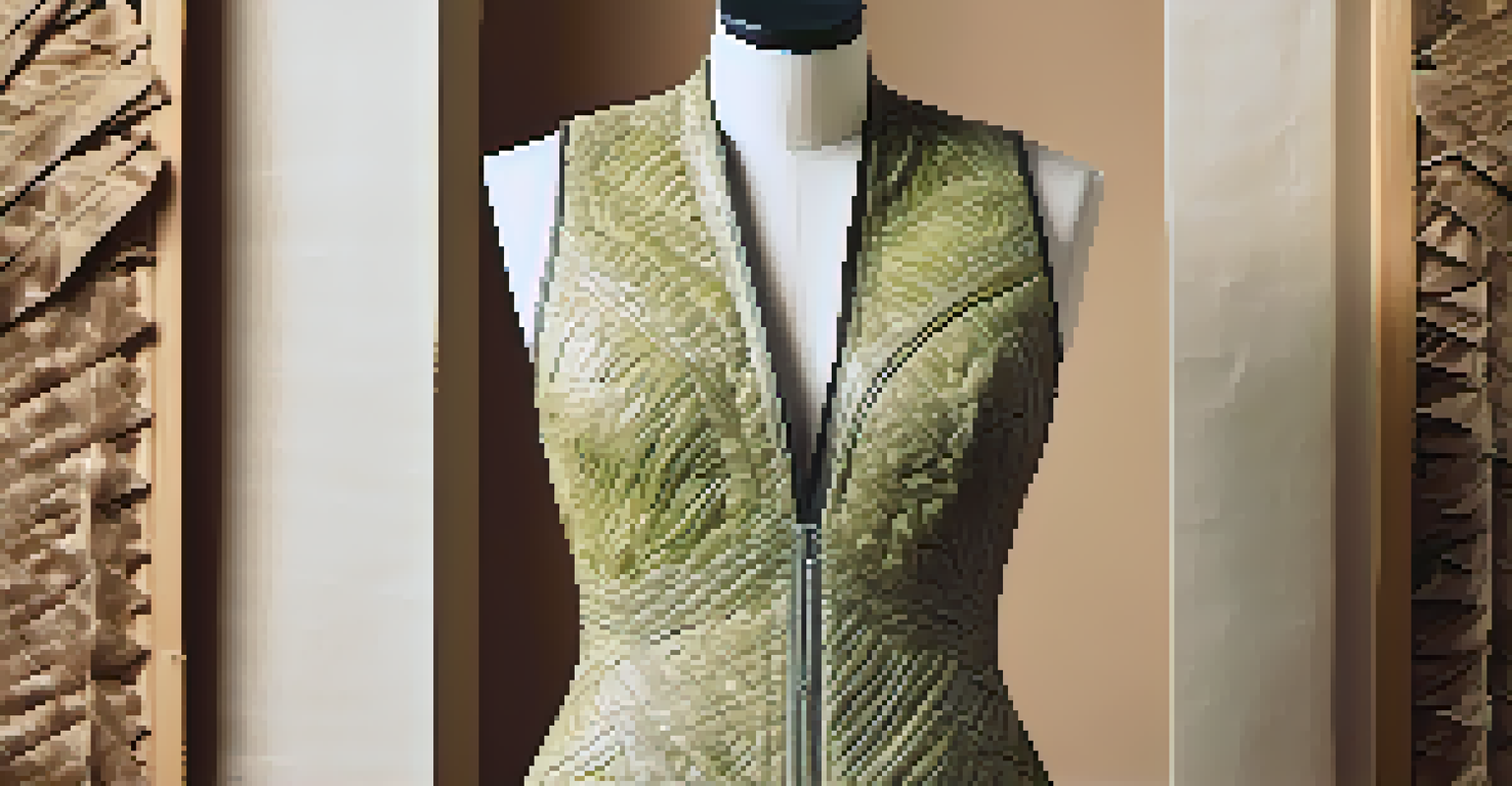Sustainable Fashion Brands Leading with Plant-Based Materials

Understanding the Shift Towards Sustainable Fashion
The fashion industry is undergoing a significant transformation towards sustainability, driven by growing consumer awareness. As people become more conscious of the environmental impact of their clothing, brands are responding by adopting eco-friendly practices. This shift is particularly evident in the rise of plant-based materials, which offer a more sustainable alternative to traditional textiles.
Fashion is about dreaming and making other people dream. But it can also be a powerful tool for change, and we need to harness that power.
Sustainable fashion isn't just a trend; it's a necessary evolution in how we think about clothing. By prioritizing the use of natural fibers and biodegradable materials, brands are minimizing waste and reducing their carbon footprint. This change not only benefits the environment but also appeals to consumers looking for ethical purchasing options.
Plant-based materials, such as organic cotton, linen, and innovative fabrics made from fruits and vegetables, are at the forefront of this movement. These materials not only reduce reliance on synthetic fibers but also promote biodiversity and healthier agricultural practices. As a result, the fashion landscape is becoming increasingly intertwined with sustainability.
Innovative Plant-Based Materials in Fashion
Several brands are leading the charge in utilizing innovative plant-based materials, making strides towards more sustainable solutions. For example, Piñatex, a leather alternative made from pineapple leaves, is gaining popularity for its unique texture and eco-friendly production process. This material not only repurposes agricultural waste but also supports local farmers in the Philippines.

Another exciting development is the use of Tencel, derived from sustainably sourced wood pulp. This biodegradable fabric is not only soft and breathable but also produced in a closed-loop system that significantly reduces water and chemical usage. Brands that incorporate Tencel are showcasing how luxury can align with sustainability.
Sustainable Fashion is Essential
The fashion industry is shifting towards sustainability as consumers demand eco-friendly practices and materials.
Hemp is also making a comeback in the fashion world, known for its durability and low environmental impact. As a fast-growing crop that requires minimal resources, hemp is becoming a go-to for brands seeking eco-friendly materials. These examples highlight the creativity and innovation driving the sustainable fashion movement.
Notable Sustainable Fashion Brands to Watch
Several brands are making headlines for their commitment to sustainability and plant-based materials. One such brand is Reformation, known for its trendy styles and eco-conscious practices. They prioritize using sustainable fabrics, including Tencel and organic cotton, while also offering transparency about their environmental impact.
The best way to predict the future is to create it.
Another standout is Stella McCartney, a pioneer in sustainable luxury fashion. Her brand consistently utilizes innovative materials like Piñatex and recycled fabrics, proving that high fashion can also be ethical. McCartney's approach inspires others in the industry to rethink their material choices and production processes.
Finally, look out for Eileen Fisher, which focuses on responsible sourcing and creating timeless pieces. They have a strong commitment to using organic and plant-based materials while promoting circular fashion through their take-back program. These brands illustrate the diverse approaches to sustainability in fashion today.
The Benefits of Plant-Based Fashion
Choosing plant-based materials in fashion comes with a host of benefits, both for the environment and consumers. Firstly, these materials are often biodegradable, meaning they can break down naturally without contributing to landfill waste. This reduces the overall impact of clothing on the planet, addressing one of the industry’s biggest challenges: textile waste.
Additionally, plant-based materials are generally produced with fewer harmful chemicals compared to synthetic alternatives. This means that they are often safer for both the environment and the people who wear them. By opting for organic cotton or Tencel, consumers can support healthier farming practices that promote soil health and biodiversity.
Innovative Materials Lead the Way
Brands are increasingly using plant-based materials like Piñatex and Tencel to create stylish, sustainable clothing.
Lastly, plant-based fashion often carries a unique story, connecting consumers to the origins of their clothing. Understanding the journey from farm to fabric enhances the emotional value of a garment, making it more than just a piece of clothing. This connection fosters a deeper appreciation for sustainable choices.
Challenges Facing Plant-Based Fashion Brands
Despite their positive impact, plant-based fashion brands face several challenges in the market. One of the primary hurdles is the higher cost of sustainable materials, which can translate to higher prices for consumers. This can make it difficult for brands to compete with fast fashion retailers that offer cheaper, synthetic options.
Additionally, sourcing sustainable materials can be complicated and time-consuming. Brands must ensure that their suppliers adhere to ethical practices and meet sustainability standards, which can create logistical challenges. This complexity can deter some companies from fully committing to sustainable practices.
Lastly, there is still a lack of consumer awareness about the benefits of plant-based fashion. Many consumers are still unaware of the environmental impact of their clothing choices, which makes it challenging for brands to communicate their value proposition effectively. Education and advocacy will be crucial in driving the growth of plant-based fashion.
The Future of Plant-Based Fashion
The future of plant-based fashion looks promising as more brands embrace sustainability in their practices. Innovations in material science are leading to the development of new, eco-friendly fabrics that can mimic the qualities of traditional textiles. This means that as technology advances, consumers will have even more stylish and sustainable options to choose from.
Moreover, the growing demand for transparency in supply chains is prompting brands to adopt more ethical practices. Consumers are increasingly interested in where their clothes come from and how they are made, pushing brands to prioritize sustainability. This shift is likely to expand the market for plant-based fashion.
Consumers Can Drive Change
By choosing sustainable brands and reducing consumption, consumers play a crucial role in supporting the movement towards eco-friendly fashion.
As the conversation around sustainability continues to evolve, plant-based materials will play an integral role in shaping the future of the fashion industry. With a focus on innovation and ethics, we can anticipate a more sustainable and responsible approach to fashion that benefits both people and the planet.
How Consumers Can Support Sustainable Fashion
Consumers play a vital role in supporting sustainable fashion brands that prioritize plant-based materials. One of the simplest ways to contribute is by choosing to shop from brands that are committed to eco-friendly practices. Researching brands and looking for certifications like Fair Trade or GOTS (Global Organic Textile Standard) can help consumers make informed choices.
Another impactful way to support sustainable fashion is by reducing overall consumption. Instead of buying new clothes frequently, consider investing in high-quality, timeless pieces that can be worn for years. Additionally, participating in clothing swaps or buying second-hand can extend the life of garments and reduce textile waste.

Lastly, spreading the word about sustainable fashion and supporting brands that align with your values can help create a ripple effect. By sharing your favorite sustainable brands on social media or discussing the importance of eco-friendly fashion with friends, you can help raise awareness and encourage others to make conscious choices.